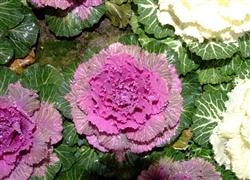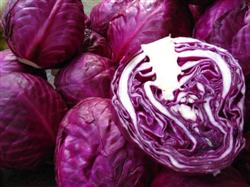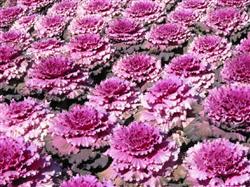How can kale be planted with seeds?

How can kale be planted with seeds? Please give detailed instructions to introduce the varieties of Brassica napus, which are native to Greece and other countries along the Mediterranean coast of Europe and have a long history of cultivation in some countries in Europe and the United States. In recent years, it has been introduced from the United States, the Netherlands, Germany and other countries, and has been planted as a specialty on the outskirts of Beijing, Shanghai and other cities. Kale has wide adaptability, cold resistance, heat resistance, fertilizer and water resistance, easy cultivation, and multiple harvesting at one time, the harvest time can be as long as 6 months, and can be planted in most parts of the country. Its leaf shape is peculiar, the leaf edge is pinnately split, beautiful, among which the color varieties have high ornamental value, which can be planted and sold as potted vegetables, and can also be planted in the roadside and flower beds of the park to beautify the environment. 1. Botanical characteristics: the main root of kale is underdeveloped, and there are more fibrous roots, and the main root groups are distributed in the soil layer around 30cm. The stem is erect, fleshy, sturdy, the plant height is 40cm to 80cm, the leaf is green, long oval, the margin is pinnately divided, the leaf is thicker, and the degree of leaf wrinkling varies from variety to variety. The petiole is longer, accounting for about 1 / 3 of the whole leaf. Racemes, yellow flowers, cross-pollination. The fruit is a pod, the seeds are round, yellowish brown to dark brown, and the weight of a thousand seeds is 3% 4g. Second, planting conditions 1. Temperature kale prefers mild climate conditions and has strong cold resistance. The seeds could germinate slowly under the condition of 3-5 ℃, and the germination was the fastest at 20-25 ℃, and more than 30 ℃ was not conducive to germination. The optimum temperature for stem and leaf growth is 18: 20 ℃ and 8: 10 ℃ at night, but it can withstand the low temperature of-4 ℃. It can withstand brief frost during the growth period, and can still grow normally after the temperature rises. It is also resistant to high temperature and can grow under the condition of 30-35 ℃, but the leaf fiber increases, the texture hardens and the quality decreases. two。 Kale is a long-day crop, which has a certain size of nutrients in the process of growth and development, completes the vernalization stage at lower temperature and blossoms and bears fruit under long sunshine. Longer sunshine and stronger light are beneficial to the growth during the vegetative growth period (before the vernalization stage is completed). However, during the formation of the product, weak light is required, and strong light will promote the aging of leaves and deteriorate the flavor. 3. Kale likes to be moist, but it can endure certain drought in seedling stage and rosette stage, while sufficient soil moisture and moist air conditions are required in the product formation stage. Under the condition of soil relative humidity 75%-80% and air relative humidity 80%-90%, the growth is good, the yield is high and the quality is good. Insufficient soil moisture will seriously affect leaf growth and yield will be significantly reduced. 4. Soil and nutrient kale have wide adaptability to soil, but cultivation in loam rich in organic matter is more beneficial to improve yield and quality. Suitable for neutral or slightly acidic soil, not suitable for planting in low-lying land prone to waterlogging. Like fertilizer, need a lot of fertilizer. Because of the long harvest time, the requirements of nitrogen fertilizer must be met, and phosphorus, potassium and trace elements must be applied together. 3. Main cultivation techniques 1. At present, the selected improved varieties mainly include gull series, Osaka series, Nagoya series, Finch series, etc., which are suitable for planting in Shandong area, with strong growth potential, neat and consistent growth, light green leaves, many foliage, soft and tender texture, good taste, high calcium content, beautiful appearance, good ornamental, strong disease resistance, good stress resistance and high yield. North China can be planted in facilities such as unheated greenhouses and improved sunny beds. two。 In the cultivation season, the northern region is planted in the open field in spring and autumn, and can be planted in the protected field in spring, autumn and winter. The seed consumption is 20,25g per 667 square meters. The spring protected field was planted from December to February, planted from January to March, and harvested from March to June. The spring open field was planted in mid-late February, planted from late March to early April, and harvested from early May to June. Autumn open field was planted from July to August, planted from August to September, and harvested from September to November. Autumn protected field was planted from August to September, planted from September to October, and harvested from October to May. Various localities can also flexibly determine the planting period according to specific climatic conditions, market demand and stubble arrangements. 3. Most of the seedlings are raised and transplanted, and mechanical or artificial direct seeding can also be used for planting in a large area. A seedling bed of 1015 square meters is required for every 667m2. High-quality mature organic fertilizer 3kg is applied per square meter and mixed well with the bed soil. There are two ways of strip sowing and sowing, strip sowing is ditched according to 6cm distance, 2~3cm sows 1 seed, sowing should be carried out after pouring through the bottom water, the seed should be evenly sown, and the sifted fine soil after sowing is about 1cm thick. Plastic film should be covered after sowing in winter to keep the bed soil moist and raise the ground temperature. The soil temperature of nursery bed should be about 20 ℃, room temperature 20: 25 ℃ in daytime and 10 ℃ at night. 2Seedling once with 3 true leaves, and the distance between them was 6cm × 10cm. The standard of strong seedling: seedling age 30-35 days, true leaves 5-6, Hypocotyl internodes short, leaves dark green, root system well developed, no diseases and insect pests. After planting, slow seedlings grow fast and have strong resistance to adverse environment and diseases. 4. Fertilization and planting need a large amount of fertilizer and a long harvest time, so it is necessary to apply sufficient base fertilizer and topdressing for many times. The mature fine organic fertilizer 2000kg was applied to base fertilizer every 667m2, then spread evenly, ploughed deeply and leveled to make a flat or high border (suitable for clayey soil) with a length of 6m and a width of 1.2m. Each row was planted with 2 rows, row spacing 60cm, plant spacing 40cm, and about 2800 plants were planted per 667m 2. 5. After slow seedling management, ploughing and loosening the soil for 1 and 2 times, in order to increase the soil temperature, promote root growth, and combined with weeding. Less watering in the early stage will make the soil wet and dry; after 10 leaves, the watering times will increase, often keeping the soil moist, but the amount of water each time should not be too large, it is better to water frequently with small water, which is beneficial to growth; drip irrigation facilities should be installed when there are conditions. It is necessary to keep warm and protect against cold in protected cultivation in winter. Kale has strong cold resistance, but in order to ensure exuberant growth, the protected ground should be covered with plastic film about 15 days before planting or according to the external environmental conditions, when the ambient temperature is lower than 5 ℃. After exposure, ventilation should be carried out to remove indoor humidity and keep 15: 20 ℃ during the day and 5: 10 ℃ at night. Fourth, pest control 1. Black rot mainly harms leaves, which is a vascular bundle disease caused by bacteria, resulting in vascular bundle necrosis and blackening, and small black spots or black stripes appear on the veins of real leaves. Most of the pathogens invade from the water holes on the leaf edge and begin to show "V" shaped disease spots. This part of the vein necrosis and blackening. If invading from the wound, irregular yellowish plaques are formed, the diseased plants are removed in time at the initial stage of the disease, and the diseased plants are sprayed with 14% loramine copper or 77% wettable powder at the initial stage of the adult disease, once every 7 to 10 days for 2 times in a row. two。 Downy mildew mainly harms leaves. After susceptibility to the disease, white frost appears first, and then dies. When humidity is high, loose white mildew occurs on the back or surface of the leaves. At the initial stage of the disease, Chlorothalonil or 40% aluminum triethyl phosphate wettable powder or 70% chlorothalonil wettable powder or 72.2% Prike water agent were sprayed once every 7 days for 2 times in a row. 5. Sclerotinia sclerotiorum, also known as sclerotia soft rot, mainly harms the base of the stem and leaves, light brown disease spots appear on the leaf margin in the early stage, soft rot in the later stage, white or gray flocculent mycelium are produced under high humidity conditions, and black mouse fecal sclerotia is formed. At the initial stage of the disease, 50% green ammonium nitrate powder or 20% methyl phosphos EC or 50% prohydantoin wettable powder were sprayed once every 7 days. To apply fertilizer reasonably, it is recommended to use loose soil fertilizer and loose soil to break the hardening, so that the root can be breathable, drained well, breathe well and grow well. Avoid excessive application of nitrogen fertilizer resulting in excessive growth of branches and leaves, tissue tender and easy to be infected. 4. Pieris rapae was sprayed evenly with biological pesticides diluted 2000 times with insect mites at an interval of 7-10 days, spraying 2-3 times to completely kill all kinds of aphids, green insects and so on. Click to get more cabbage planting techniques click to get more vegetable planting techniques
- Prev

How can purple cabbage be planted with high yield?
How can purple cabbage be planted with high yield? Please introduce purple cabbage, also known as red cabbage, purple cabbage and so on. This kind of cabbage is cold-resistant and heat-resistant, strong adaptability, high yield, transportation resistance, growth period of 90-120 days, is one of the rare vegetables in Shandong Province, the economic benefit of planting purple cabbage is much higher than that of common cabbage varieties. ...
- Next

How to grow kale?
How to grow kale? How to manage and control diseases and insect pests? Please give guidance to kale planting methods and management methods can refer to the following techniques: sowing seedlings in mid-late February using protected areas to raise seedlings, about 50 grams per mu of land. Before sowing, pour the bottom water through the seedling bed, and then sow the seeds evenly.
Related
- Where is it suitable to grow horseradish in China? it is expected to see the middle altitude horseradish in Alishan.
- How to prevent tomato virus disease reasonably? (Control methods included)
- Many people like to plant towel gourd on the balcony. What are the main points of this method and management?
- What crops can chili peppers be mixed with?
- Fertilization techniques and matters needing attention in Tomato
- What are the grafting techniques for peach seedlings in spring?
- Harm and control methods of root swelling disease of Chinese cabbage
- What are the pests of sweet potatoes? How to prevent and cure it?
- Symptoms, causes and Control methods of navel Rot in Tomato
- The cause of "Cucumber rotten bibcock" in Farmers' planting Cucumber and its Control Plan

